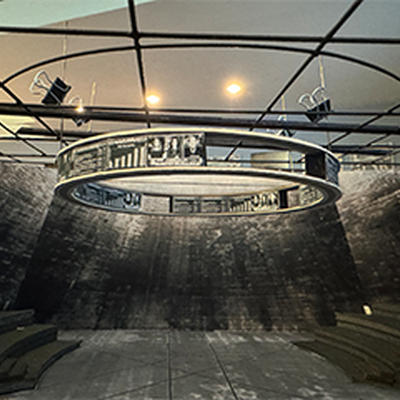Anyone who watches television news is familiar with one of the design staples of such a broadcast: the round header above the anchors. On this circular strip we see a panoply of images. When Michael Yeargan decided to use this element in his set design for Corruption, the new J.T. Rogers play, about phone hacking and the Murdoch media empire, directed by Bartlett Sher, Yeargan faced a challenge: how do you make a header work in LCT’s Mitzi E. Newhouse?
“The Mitzi is like an operating laboratory,” Yeargan told me this week as we watched a technical rehearsal. “You’re in a semi-thrust and you’re looking down on the action. With Corruption, we have to make sure that the header is integrated with the actors performing below it. We’re so glued to all the screens in our lives that it would be very easy just to watch the screens on the header and not notice what the performers are doing.”
Yeargan did not design the header’s imagery – that’s the province of Ben Pearcy of 59 Productions. But, in concert with Sher and the other designers, Yeargan had to make sure the set’s header, as he put it, “echoes things happening in the show below.” He added: “The media manipulation in the story spirals out of control but the balance of the design elements can’t spiral out of control. Things have to be clear for the audience.”
Yeargan confessed: “I’ve never done anything like this – it’s a big experiment.”
Given Yeargan’s track record – two Tony awards and lauded work around the world – there’s ample reason to believe this experiment will yield very satisfying results. “It will be interesting to see what happens once we have our first preview,” he said. “Someone once said that the audience is the last element of tech rehearsal. They show us what needs adjusting.”
In his distinguished career, which at LCT has included several highly popular musicals as well as Rogers’ Oslo, Yeargan has learned not only from his audiences but from his students. He is the Donald M. Oenslager Professor in the Practice of Design at the David Geffen School of Drama at Yale. “I always try to get students in to see shows I’ve worked on. And I welcome their feedback. We critique their work so why shouldn’t they critique ours?”
In his teaching, Yeargan insists that students sketch their designs, at least initially. “It’s hard to keep students off the computer. We almost have to force them to draw. The computer may be great as an extension of what you put down on paper. But only something you commit to paper will look like what only you can do.”
Yeargan said there’s another reason to foster drawing. “If you’re in a bar and discussing design with a director you may not have a sketchbook. Designers will tell you that some of the best sketches they’ve ever done have been on cocktail napkins. That work gives an immediate idea – a director doesn’t have to wait three weeks while you make a set model.”
True to Yeargan’s philosophy, his design for Corruption began with sketching. “I always try to practice what I preach. I sketch to come up with ideas. Most of them are discarded of course.”
Corruption doesn’t begin previews until next Thursday, February 15th, so I’m not going to give away everything that Yeargan revealed in this interview. I will leave you with this: one of the inspirations for a major element of the set was the photo of a missile silo. Come see Corruption and you’ll see what that means.
Brendan Lemon is a freelance journalist in New York.
